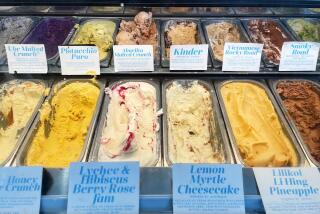We Dare You to Eat This Fruit : Durian: Some find it addictive. It has a distinctive pungent aroma and a flesh reminiscent of runny Brie cheese and scrambled eggs.
- Share via
First came the kiwi. Then the cherimoya, carambola and ugli fruit. The newest arrival on the exotic fruit scene is the durian, which makes the other exotics seem as commonplace as plums.
Actually, the durian looks less like a fruit than a porcupine. Imagine an elongated, olive drab-colored melon covered with short, sharp, pyramid-shaped spikes. A single fruit measures 6 to 8 inches in diameter and weighs 4 to 8 pounds. Durians grow on a tree that resembles an elm.
Native to Southeast Asia, durian has been called the “king of fruits” and the “cheese that grows on trees.” Both descriptions are apt. The fruit is so popular in Vietnam that people have been known to pawn the coat off their backs to buy one. “Given the choice between buying a whole dinner or a single durian,” observes a Vietnamese friend of mine, “most of us would take the latter.”
The durian’s most distinctive feature is its aroma, which might charitably be described as pungent. The smell has also been likened to moldy cheese, raw sewage or a town dump on a hot summer day. The aroma is so penetrating that certain Asian airlines won’t let passengers bring durians into the cabin. Classy hotels forbid eating the fruit in the rooms.
I once brought a durian to a Chinese restaurant in Boston for dessert. Within moments, my table had attracted a crowd. In Vietnam, says my friend, the poor congregate near where people are eating durians, if only to partake of the smell.
Beneath the spiked rind and behind the offensive aroma is one of the most intriguing taste sensations on earth. The cream-colored flesh of the durian looks like a cross between runny Brie cheese and scrambled eggs. The fruit’s seeds are the size and color of chestnuts. The soft, creamy consistency of the durian makes me think of custard. The flavor hints at honey, melon, papaya and cheese--with a hint of green onions. Like caviar or foie gras, durian is an acquired taste, but one that quickly becomes addicting.
And people pay dearly for the habit. In this country, a single durian can cost as much as $40. A 4-pound fruit will feed six timid Westerners, but an Asian aficionado might polish it off alone.
Durians are in season in May. If you live in an area with a large Southeast Asian population, you may be able to buy them fresh or freshly frozen. Canned durian is available year-round at many Oriental markets. The fruit freezes well.
When buying durians, let your nose be your guide: the ranker the smell, the riper the fruit. To eat a durian, cut off the end opposite the stem, then peel the fruit like an orange. Inside you will find six to eight pulpy segments enclosed in a pithy casing. Alternatively, you can cut the fruit in half widthwise and scoop out the flesh with a spoon.
Food historian Waverly Root sums up the hazards of eating durian: “Like garlic, it imparts its fragrance to the breath of those who indulge in it. The only way to protect yourself from a durian eater is to eat durian yourself!”
Durian is one of the world’s most expensive fruits, but a little goes a long way. This unusual milk shake can be served as a beverage or dessert. The recipe comes from Dong Khanh, a tiny Vietnamese restaurant in Boston’s Chinatown.
DURIAN MILK SHAKE
2 ounces fresh, frozen or canned durian (1/4 cup pulp)
2 tablespoons sweetened condensed milk
Juice of 1 lime or to taste
1 tablespoon sugar or to taste
1 cup coarsely crushed ice
1 sprig mint
Trim any pith or rind off durian. Combine durian, condensed milk, lime juice, sugar and ice in blender. Puree until smooth. Add additional lime juice or sugar to taste. Pour shake into chilled glass and garnish with mint sprig. Makes 1 serving.
More to Read
Eat your way across L.A.
Get our weekly Tasting Notes newsletter for reviews, news and more.
You may occasionally receive promotional content from the Los Angeles Times.









